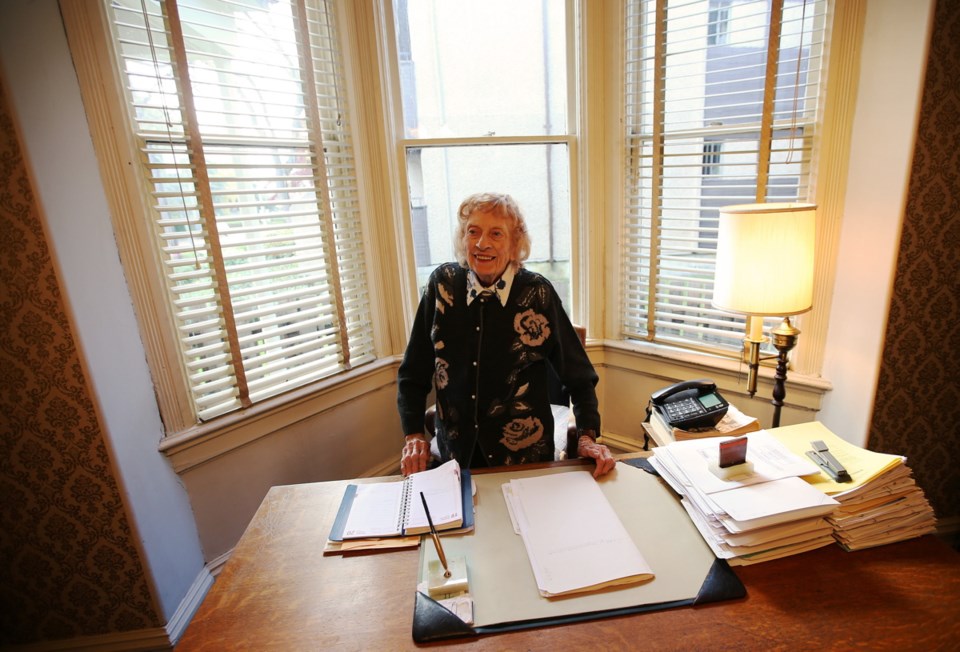If anyone could speak about the barriers women have overcome in the legal profession, you’d think it might be Constance Isherwood.
She was called to the bar 65 years ago, before women had passed such milestones as being appointed to the Supreme Court of Canada or winning legal protection from discrimination at work. By the time she had practised for 20 years, in 1971, women still comprised only about five per cent of lawyers.
But you won’t hear the Victoria lawyer, now 96, saying she was ever treated differently because of her gender.
“I haven’t felt barriers or anything too much in the way of criticism,” said Isherwood, who this week became the first woman to receive the Law Society of B.C.’s highest honour for lifetime achievement.
The petite woman is warm and composed, introducing herself as “Mrs. Isherwood.” She speaks carefully and clearly from behind her desk in the 1887 Fort St. heritage house, where she continues to work in general civil law. She says she didn’t have a passion for law when she started — she played piano and drums, and would have liked to have been in an orchestra. But she worked for a lawyer in town who encouraged her to enrol at the University of British Columbia’s law school, and she agreed it was a good idea.
That launched what would be a series of trailblazing landmarks for B.C. women in the legal profession.
When she entered law school in 1948, Isherwood was one of only eight women in a class of 208. Two of those women dropped out by the time Isherwood graduated at the top of the class in 1951, becoming the first woman to win the law society’s gold medal.
Isherwood, née Holmes, says she has never felt left out or had to work harder to prove herself. In school, men copied her homework and gave her the nickname “Sherlock Holmes” for her meticulous search for clues in a case.
“There was just a feeling of camaraderie,” she said.
After graduating, she was welcomed back to Victoria with a job by her mentor, Ernest Tait, and formed Tait & Holmes. In 1963, she opened Holmes & Isherwood with her husband, Foster Isherwood. She continues to see clients every afternoon, making her the oldest practising lawyer in the province. Her favourite thing about her job is her clients, but she is beginning to consider retirement. “The more I think about it, the more I think it’s rather a good idea. I must do it one of these times. Maybe next year,” she said.
Asked about the biggest shifts for women in her profession, Isherwood declines to comment on gender. Instead, she points to technology: The introduction of an “electric adding machine” was the first revolution.
In fact, Isherwood is acknowledged by many for breaking barriers. Her gold medal is on the law society’s list of milestones for B.C. women in the law, which also includes the first female appointee to the B.C. Supreme Court (Patricia Proudfoot, 1977), president of the Canadian Bar Association’s B.C. branch (Marlene Scott, 1980) and appointee to B.C. Court of Appeal (Beverley McLachlin, 1985).
Isherwood said it’s been “a joy” to watch more women enter the profession.
Although much has been gained, efforts are still underway to bridge the gap between men and women. Today, women make up about 39 per cent of B.C. lawyers. The law society projects that women will reach law-partner parity with men in 2088, based on current rates.
And women continue to leave the profession at higher rates than men, citing a lack of mentorship and need for greater flexibility and control over work-life balance as factors. Only two-thirds of women called to the bar in 2003 were still practising in 2008, compared with 80 per cent of men.
Gillian Calder, associate dean of the University of Victoria’s faculty of law, descibed Isherwood as a force of nature. “Constance Isherwood is a spectacular woman. But she’s very much anomalous in a profession in which the number of women running their own law firms and holding partnership positions is still lower than men.”
UVic Law had its highest rate of first-year women this year, at 64 per cent. But that has yet to work its way up to higher ranks. And the profession is still catching up when it comes to representing the country’s diversity in terms of race, sexual orientation and gender identity, Calder said. When Isherwood went to law school, indigenous people still couldn’t even vote in Canada.
Kathryn Berge, who nominated Isherwood for this week’s award, leased office space from Holmes & Isherwood as a young lawyer. She said Isherwood led others by example, describing her as sharp, committed, disciplined and balanced.
“She was so talented [when she graduated], that the benchers of the day had a meeting and decided she didn’t need to article. I’ve never gone into the archives to see if that’s happened on another occasion, but I doubt it,” she said.
Berge said her own experience as a female lawyer has been a positive one, too.
Dean Lawton, a Victoria-based Law Society bencher, said Isherwood was selected for the award based on her integrity, professional achievement, public service and contribution to legal reform. “I’ve been lawyering now for over 30 year and I always remember her as a mentor to many young lawyers — and now older lawyers.”
He said it’s long overdue for a woman to be recognized with the award. “I expect going forward you’ll see more women being recognized.”
